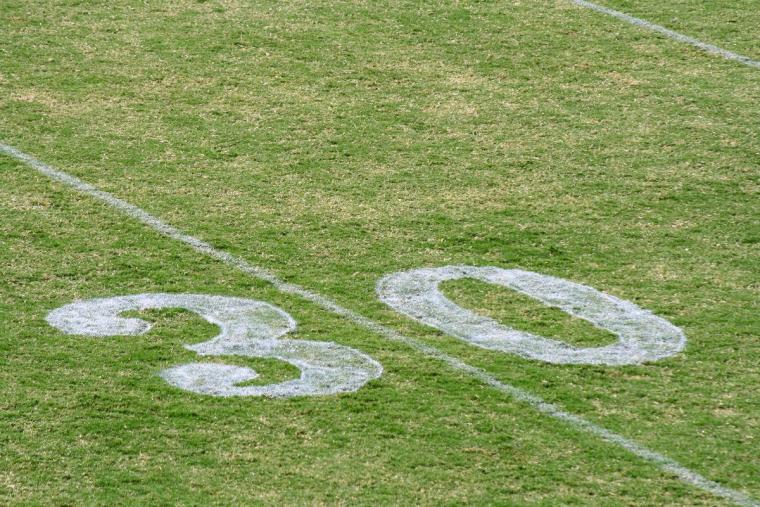
It was just prior to the holidays that the NFL Players Association (NFLPA) came out with a blunt message to the NFL. In sum, the message said: It’s your fault injuries are happening on fields. The funny thing? The issues they were complaining about, subpar field conditions and too many people on the sidelilnes, have been plaguing youth sports for years.
While the NFLPA’s message, written by its president, JC Tretter, initially touched on surface types, it spent far more time alleging that the NFL was allowing play on fields that had visual abnormalities, such as natural grass facilities that had suffered damage and had not been repaired before games.
The biggest part of that problem, Tretter said, lies with the current methods of inspection of fields prior to play, and the fact that those methods have become outdated, given the development of newer and better surface testing methods.
 “We need to raise the field standards and test the safety and performance of all field surfaces,” stated Tretter. “The current mandatory field practices (or MPs) only evaluate the maintenance condition of the surface. This includes surface hardness. These standards are more than 13 years old. The results tell you nothing about how safe it is to play on the field.
“We need to raise the field standards and test the safety and performance of all field surfaces,” stated Tretter. “The current mandatory field practices (or MPs) only evaluate the maintenance condition of the surface. This includes surface hardness. These standards are more than 13 years old. The results tell you nothing about how safe it is to play on the field.
We need to accelerate the joint development of new performance and safety standards that can be used to test every single field. The good news is that the NFLPA and NFL are currently engaged in research to, for the first time, establish these standards.
Until we have those standards in place, the NFL needs to be much more conservative when we have visible issues with the fields. The current field inspections do not account for performance and safety, so we should stop saying that these fields are safe to play on based on the fact they passed said inspection.”
The NFL’s current field safety testing standards can be found here.
Youth sports programs, particularly at the municipal and high school level, often deal with substandard field conditions. A month ago, in New York State, noted an article in The Mid Hudson News, voters approved a loan of $11.16 million to the Eldred Central School District to make repairs at two facilities, including the Eldred Junior Senior High School, which would receive an all-weather football field and track. In recent years, reporters pointed out, one-third of all home sports events were cancelled due to unsafe conditions for student athletes.
In Tennessee, all 15 high schools in the Metro Nashville Public Schools were to get new fields as well to create safer playing conditions for student athletes. News Channel 5 reported that the total was expected to be $15 million, funded through a partnership with the Tennessee Titans and Nashville-based nonprofit group The Fans Inc.
Too Many People on the Sidelines
 Another safety threat to player safety, noted Tretter, was the presence of too many non-playing people and too much equipment on the sidelines. Over the years, players in pursuit of the ball have collided with other players, with officials, with coaches and even with cheerleaders, as well as with media members and security personnel, all of whom were stationed on the sidelines. (This YouTube video has a compilation of sideline mishaps – and as it shows, even referees have run into crowds on the sidelines while trying to keep an eye on the action on the field).
Another safety threat to player safety, noted Tretter, was the presence of too many non-playing people and too much equipment on the sidelines. Over the years, players in pursuit of the ball have collided with other players, with officials, with coaches and even with cheerleaders, as well as with media members and security personnel, all of whom were stationed on the sidelines. (This YouTube video has a compilation of sideline mishaps – and as it shows, even referees have run into crowds on the sidelines while trying to keep an eye on the action on the field).
“We have seen too many injuries because of this issue, and it really should be a simple fix,” Tretter stated. “Give the players their space to perform. Year after year, the NFL tells us they will look into it; and year after year, nothing ever changes.”
This is hardly a new issue and is something event owners and venue operators, as well as coaches and officials at high schools and youth sports, battle on a regular basis as they try to keep parents (and in some cases, fellow students) away from the field during games in any number of sports (not just football).
While it’s unknown whether the NFLPA’s words will kickstart change within the league, it just might be a wake-up call to field owners at the youth level, making clear the importance of well-maintained surfaces, as well as the need to limit the number of individuals on the sidelines.

